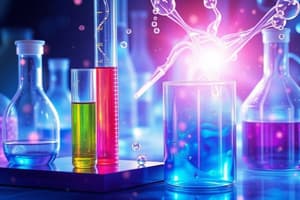Podcast
Questions and Answers
What is the main principle behind chromatography?
What is the main principle behind chromatography?
- Different components move at different speeds through a stationary phase. (correct)
- Components are identified based on their color.
- Chromatography separates components based solely on their mass.
- All components of a mixture are dissolved in a single solvent.
Which statement about Thin Layer Chromatography (TLC) is accurate?
Which statement about Thin Layer Chromatography (TLC) is accurate?
- TLC involves a thin absorbent layer for separation. (correct)
- The TLC technique is suitable for identifying components by their electrical charge.
- The stationary phase in TLC is always a gas.
- TLC uses a liquid mobile phase only.
How can spectroscopy and spectrometry be utilized in forensic science?
How can spectroscopy and spectrometry be utilized in forensic science?
- To determine the concentration of gases in the air.
- To identify molecules based on their color spectrum.
- To analyze the interaction between light and matter to identify substances. (correct)
- To analyze the weight of solid compounds.
What is typically investigated when analyzing fibres in forensic examinations?
What is typically investigated when analyzing fibres in forensic examinations?
What role does the mobile phase play in chromatography?
What role does the mobile phase play in chromatography?
What does the area under each peak in HPLC represent?
What does the area under each peak in HPLC represent?
Which of the following is NOT an advantage of HPLC compared to GC?
Which of the following is NOT an advantage of HPLC compared to GC?
Which statement about HPLC and GC is true?
Which statement about HPLC and GC is true?
What is a primary advantage of using Gas Chromatography (GC)?
What is a primary advantage of using Gas Chromatography (GC)?
Which of the following is an application of HPLC?
Which of the following is an application of HPLC?
What is the basis of infra-red spectroscopy?
What is the basis of infra-red spectroscopy?
What factors affect the stretching frequency in molecular vibrations?
What factors affect the stretching frequency in molecular vibrations?
Why is chromatographic comparison not always definitive as evidence?
Why is chromatographic comparison not always definitive as evidence?
Which of the following is NOT a component measured by infra-red spectroscopy?
Which of the following is NOT a component measured by infra-red spectroscopy?
What type of molecular features does infra-red spectroscopy detect?
What type of molecular features does infra-red spectroscopy detect?
In terms of retentivity, what is a necessary comparison in chromatographic evidence?
In terms of retentivity, what is a necessary comparison in chromatographic evidence?
What property differentiates IR absorptions among various molecules?
What property differentiates IR absorptions among various molecules?
What does HPLC stand for in the context of evidence collection?
What does HPLC stand for in the context of evidence collection?
What is the range for the fingerprint region in infrared spectroscopy?
What is the range for the fingerprint region in infrared spectroscopy?
In mass spectrometry, which factor primarily affects the deflection of ions in a magnetic field?
In mass spectrometry, which factor primarily affects the deflection of ions in a magnetic field?
What process is described when a sample is vaporized and bombarded by electrons in mass spectrometry?
What process is described when a sample is vaporized and bombarded by electrons in mass spectrometry?
Which bond type is associated with the highest energy and thus found at the highest frequency in infrared spectroscopy?
Which bond type is associated with the highest energy and thus found at the highest frequency in infrared spectroscopy?
What is the significance of the mass of the molecular ion (M+) in a mass spectrometry analysis?
What is the significance of the mass of the molecular ion (M+) in a mass spectrometry analysis?
What component is known as the active ingredient in heroin according to infrared spectroscopy?
What component is known as the active ingredient in heroin according to infrared spectroscopy?
In infrared spectroscopy, what does a match in the fingerprint region indicate about an unknown compound?
In infrared spectroscopy, what does a match in the fingerprint region indicate about an unknown compound?
How does the voltage applied during ionization in mass spectrometry typically range?
How does the voltage applied during ionization in mass spectrometry typically range?
Which type of bond is associated with lower energy absorption in infrared spectroscopy?
Which type of bond is associated with lower energy absorption in infrared spectroscopy?
What is the outcome if an unknown compound's infrared spectrum matches that of a known standard?
What is the outcome if an unknown compound's infrared spectrum matches that of a known standard?
What is the primary purpose of using a thin layer chromatography (TLC) plate?
What is the primary purpose of using a thin layer chromatography (TLC) plate?
In thin layer chromatography, how can invisible compounds be made visible?
In thin layer chromatography, how can invisible compounds be made visible?
What indicates that an unknown sample in TLC possibly contains standard compounds?
What indicates that an unknown sample in TLC possibly contains standard compounds?
Which of the following accurately describes gas chromatography (GC)?
Which of the following accurately describes gas chromatography (GC)?
What does the area under the peak in gas chromatography represent?
What does the area under the peak in gas chromatography represent?
How does high performance liquid chromatography (HPLC) differ from gas chromatography (GC)?
How does high performance liquid chromatography (HPLC) differ from gas chromatography (GC)?
What prevents all components from showing distinct spots on a TLC plate?
What prevents all components from showing distinct spots on a TLC plate?
What is a common characteristic of compounds in gas chromatography?
What is a common characteristic of compounds in gas chromatography?
Which of the following is NOT a feature of gas chromatography?
Which of the following is NOT a feature of gas chromatography?
What role does pressure play in high performance liquid chromatography?
What role does pressure play in high performance liquid chromatography?
Why might an unknown sample in TLC not show a corresponding standard spot?
Why might an unknown sample in TLC not show a corresponding standard spot?
Which method is considered primarily qualitative in nature, indicating the presence of compounds but not their quantities?
Which method is considered primarily qualitative in nature, indicating the presence of compounds but not their quantities?
What is a determining factor for the separation of compounds in gas chromatography?
What is a determining factor for the separation of compounds in gas chromatography?
What happens when an unknown sample passes through a gas chromatography column?
What happens when an unknown sample passes through a gas chromatography column?
What is the molecular weight of cocaine (C17H21NO4)?
What is the molecular weight of cocaine (C17H21NO4)?
What does the fragmentation pattern in mass spectrometry act like?
What does the fragmentation pattern in mass spectrometry act like?
Which process combines separation and identification in a single instrument?
Which process combines separation and identification in a single instrument?
What are isomers?
What are isomers?
In mass spectrometry, the degree of deflection of ions depends on what ratio?
In mass spectrometry, the degree of deflection of ions depends on what ratio?
What technique is typically used to separate mixtures before mass spectrometry?
What technique is typically used to separate mixtures before mass spectrometry?
Which statement about mass spectrometry is true?
Which statement about mass spectrometry is true?
How is identification achieved in Infrared spectroscopy?
How is identification achieved in Infrared spectroscopy?
What is the role of an auto-sampler in GC-MS?
What is the role of an auto-sampler in GC-MS?
Which component of cocaine does not prove its identity?
Which component of cocaine does not prove its identity?
What happens to most molecules in a mass spectrometer during the process?
What happens to most molecules in a mass spectrometer during the process?
Why might two molecules with the same molecular weight differ in mass spectrometry?
Why might two molecules with the same molecular weight differ in mass spectrometry?
What is a key function of Gas Chromatography in GC-MS?
What is a key function of Gas Chromatography in GC-MS?
Flashcards
Chromatography
Chromatography
A technique to separate components of a mixture based on their different movement speeds through a stationary phase.
Thin Layer Chromatography (TLC)
Thin Layer Chromatography (TLC)
A type of chromatography using a thin layer of absorbent material (stationary phase) on a flat surface (plate).
Stationary Phase
Stationary Phase
The absorbent material in chromatography, that the components of the mixture move over.
Mobile Phase
Mobile Phase
Signup and view all the flashcards
Mixture Separation
Mixture Separation
Signup and view all the flashcards
HPLC
HPLC
Signup and view all the flashcards
HPLC Peak Area
HPLC Peak Area
Signup and view all the flashcards
Why use HPLC?
Why use HPLC?
Signup and view all the flashcards
HPLC vs. GC
HPLC vs. GC
Signup and view all the flashcards
Benefits of GC
Benefits of GC
Signup and view all the flashcards
TLC Standard
TLC Standard
Signup and view all the flashcards
Presumptive Test
Presumptive Test
Signup and view all the flashcards
Gas Chromatography (GC)
Gas Chromatography (GC)
Signup and view all the flashcards
Mobile Phase (GC)
Mobile Phase (GC)
Signup and view all the flashcards
Stationary Phase (GC)
Stationary Phase (GC)
Signup and view all the flashcards
Retention Time (GC)
Retention Time (GC)
Signup and view all the flashcards
Quantitative Analysis (GC)
Quantitative Analysis (GC)
Signup and view all the flashcards
High Performance Liquid Chromatography (HPLC)
High Performance Liquid Chromatography (HPLC)
Signup and view all the flashcards
Mobile Phase (HPLC)
Mobile Phase (HPLC)
Signup and view all the flashcards
Stationary Phase (HPLC)
Stationary Phase (HPLC)
Signup and view all the flashcards
Sample Preparation
Sample Preparation
Signup and view all the flashcards
Infra-red Spectroscopy
Infra-red Spectroscopy
Signup and view all the flashcards
Molecular Vibrations
Molecular Vibrations
Signup and view all the flashcards
Stretching Frequency
Stretching Frequency
Signup and view all the flashcards
Bending Modes
Bending Modes
Signup and view all the flashcards
Infrared Spectrum
Infrared Spectrum
Signup and view all the flashcards
How does IR spectroscopy help identify substances?
How does IR spectroscopy help identify substances?
Signup and view all the flashcards
What are the limitations of IR spectroscopy?
What are the limitations of IR spectroscopy?
Signup and view all the flashcards
Fingerprint region
Fingerprint region
Signup and view all the flashcards
Diagnostic region
Diagnostic region
Signup and view all the flashcards
Mass spectrometry (MS)
Mass spectrometry (MS)
Signup and view all the flashcards
Molecular ion (M+)
Molecular ion (M+)
Signup and view all the flashcards
Electron bombardment
Electron bombardment
Signup and view all the flashcards
Deflection in magnetic field
Deflection in magnetic field
Signup and view all the flashcards
Spectroscopy
Spectroscopy
Signup and view all the flashcards
IR spectrum
IR spectrum
Signup and view all the flashcards
Functional group
Functional group
Signup and view all the flashcards
Vibrational modes
Vibrational modes
Signup and view all the flashcards
Molecular Weight
Molecular Weight
Signup and view all the flashcards
Isomers
Isomers
Signup and view all the flashcards
Why does molecular weight not guarantee identity?
Why does molecular weight not guarantee identity?
Signup and view all the flashcards
Mass Spectrometry
Mass Spectrometry
Signup and view all the flashcards
Fragmentation in Mass Spectrometry
Fragmentation in Mass Spectrometry
Signup and view all the flashcards
Mass Spectrum
Mass Spectrum
Signup and view all the flashcards
Mass Spectrum as a Fingerprint
Mass Spectrum as a Fingerprint
Signup and view all the flashcards
GC-MS
GC-MS
Signup and view all the flashcards
MS in GC-MS
MS in GC-MS
Signup and view all the flashcards
Auto-sampler
Auto-sampler
Signup and view all the flashcards
Combining Techniques for Analysis
Combining Techniques for Analysis
Signup and view all the flashcards
Study Notes
Forensic Science - Analysis of Mixtures and Compounds
-
Chromatography is used to separate mixtures. Common types include TLC, GC, and HPLC.
-
Thin Layer Chromatography (TLC) uses a thin absorbent layer (usually silica or alumina) as the stationary phase. A sample is applied, and a solvent moves it up the plate. Colored compounds are visible to the eye; others need chemical staining or UV light. Standards are used for comparison. Presumptive tests can be done, but not definitive.
-
Gas Chromatography (GC) separates components based on their boiling points. A sample is vaporized and carried by a carrier gas through a column. Different components travel at different speeds. The detector measures this and gives a chromatogram. This helps identify the components in the mixture.
-
High Performance Liquid Chromatography (HPLC) uses a liquid mobile phase instead of gas; suitable for non-volatile compounds. Separates by how different components interact with the stationary phase. The detector measures and provides a graph for identification and quantity, similar to GC.
-
Infrared Spectroscopy (IR) identifies compounds based on their molecular vibrations (stretching and bending of chemical bonds). Characteristic absorption bands (peaks) in the IR spectrum act as a fingerprint, identifying a compound.
-
Mass Spectrometry (MS) identifies compounds by their mass-to-charge ratio, which is measured as ions are deflected in a magnetic field by their mass. Fragmentation patterns are unique to different compounds, enabling identification.
-
GC-MS combines gas chromatography and mass spectrometry. GC separates components, and MS identifies each separated component. This is an effective hyphenated technique.
Additional Notes
- Identifying compounds and the substances present in mixtures are part of forensic science in situations like drug analysis, identifying unknown dyes in fibers and blood or other biological samples from crime scenes.
- The quantity of certain components can be measured in mixtures.
- Various techniques are used in forensics to analyze complex mixtures and identify the exact composition.
Studying That Suits You
Use AI to generate personalized quizzes and flashcards to suit your learning preferences.
Related Documents
Description
This quiz focuses on various chromatographic techniques used in forensic science to analyze mixtures and compounds. Learn about Thin Layer Chromatography, Gas Chromatography, and High Performance Liquid Chromatography, their principles, and applications in identifying substances. Test your knowledge on key concepts and techniques in forensic analysis.




